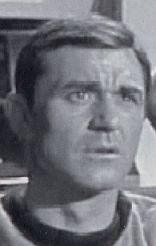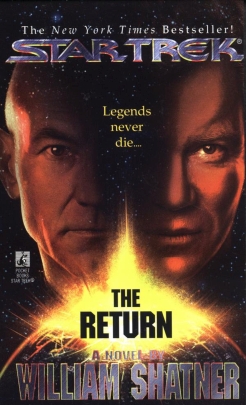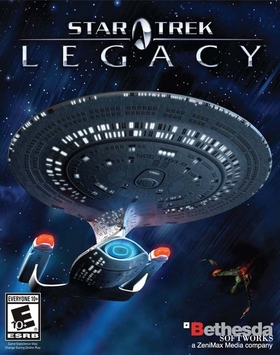
The Romulans are an extraterrestrial race in the American science fiction franchise Star Trek. They first appeared in the series Star Trek (1966–1969). They have appeared in most subsequent Star Trek releases, including The Animated Series, The Next Generation, Deep Space Nine, Voyager, Enterprise, Discovery, Picard, Strange New Worlds, and Lower Decks. They appear in the Star Trek feature films Star Trek V: The Final Frontier (1989), Star Trek VI: The Undiscovered Country (1991), Star Trek: Nemesis (2002) and Star Trek (2009). They also appear in various other spin-off media, including books, comics, toys and games.
Enterprise or USS Enterprise is the name of several fictional spacecraft, some of which are the main craft and setting for various television series and films in the Star Trek science fiction franchise. The most notable were Captain James T. Kirk's USS Enterprise (NCC-1701) from the original 1960s television series, and Captain Jean-Luc Picard's USS Enterprise (NCC-1701-D) from Star Trek: The Next Generation.
The Star Trek fictional universe contains a variety of weapons, ranging from missiles to melee. The Star Trek franchise consists mainly of several multi-season television shows and a dozen movies, as well as various video games and inspired merchandise. Many aspects of the Star Trek universe impact modern popular culture, especially its fictitious terminology and the concept of weaponry on spacecraft. The franchise has had a widespread influence on its audiences from the late 20th to early 21st century. Notably, Star Trek's science fiction concepts have been studied by real scientists; NASA described it in relation to the real world as "entertaining combination of real science, imaginary science gathered from lots of earlier stories, and stuff the writers make up week-by-week to give each new episode novelty." For example, NASA noted that the Star Trek "phasers" were a fictional extrapolation of real-life lasers, and compared them to real-life microwave based weapons that have a stunning effect.

Saavik is a fictional character in the Star Trek universe. She first appeared in the film Star Trek II: The Wrath of Khan (1982) played by Kirstie Alley. Robin Curtis took over the role for Star Trek III: The Search for Spock (1984) and Star Trek IV: The Voyage Home (1986).

"Balance of Terror" is the fourteenth episode of the first season of the American science fiction television series Star Trek. Written by Paul Schneider and directed by Vincent McEveety, it first aired on December 15, 1966.

Montgomery "Scotty" Scott is a fictional character in the science fiction franchise Star Trek. First portrayed by James Doohan in the original Star Trek series, Scotty also appears in the animated Star Trek series, 10 Star Trek films, the Star Trek: The Next Generation episode "Relics", and in numerous books, comics, and video games.
This article discusses the fictional timeline of the Star Trek franchise. The franchise is primarily set in the future, ranging from the mid-22nd century to the late 24th century, with the third season of Star Trek: Discovery jumping forward to the 32nd century. However the franchise has also outlined a fictional future history of Earth prior to this, and, primarily through time travel plots, explored both past and further-future settings.
"The Deadly Years" is the twelfth episode of the second season of the American science fiction television series Star Trek. Written by David P. Harmon and directed by Joseph Pevney, it was first broadcast December 8, 1967.
"Obsession" is the thirteenth episode of the second season of the American science fiction television series Star Trek. Written by Art Wallace and directed by Ralph Senensky, it was originally broadcast on December 15, 1967.
"The Enterprise Incident" is the second episode of the third season of the American science fiction television series Star Trek. Written by D. C. Fontana and directed by John Meredyth Lucas, it was first broadcast September 27, 1968.

"The Tholian Web" is the ninth episode of the third season of the American science fiction television series Star Trek. Written by Judy Burns and Chet Richards and directed by Herb Wallerstein, it was first broadcast on November 15, 1968.

The Return is a novel by William Shatner that was co-written with Garfield Reeves-Stevens and Judith Reeves-Stevens. It is set in the Star Trek universe but, as part of the "Shatnerverse," does not follow the timeline established by other Star Trek novels. The book's sequel is Avenger.
A collision course, also known as a kamikaze run, is the deliberate maneuver by the operator of a moving object to collide with another object. It is a desperate maneuver since it often damages or destroys both.
"The Practical Joker" is the third episode of the second season of the American animated science fiction television series Star Trek, the 19th episode overall. It first aired in the NBC Saturday morning lineup on September 21, 1974, and was written by American television writers Chuck Menville and Len Janson who together also wrote the first season episode "Once Upon a Planet". The "Rec Room" in this episode is the forerunner of the Holodeck, which plays a significant part in numerous episodes of the subsequent spin-off Star Trek series.

Star Trek: Legacy is a 2006 real-time tactics space combat video game for Microsoft Windows and Xbox 360 developed by Mad Doc Software and published by Bethesda Softworks in association with CBS Paramount Television and CBS Consumer Products. Originally slated for release in the fall of 2006 to coincide with the 40th anniversary of Star Trek, the Windows version was not released in North America until December 5, 2006, and the Xbox 360 version until December 15. In Europe, both the PC version and the Xbox 360 version were released on December 22, 2006.

The Ashes of Eden is a Star Trek novel co-written by William Shatner, Judith Reeves-Stevens, and Garfield Reeves-Stevens as part of the "Shatnerverse" series of novels. This is Shatner's first Trek collaboration.

Yesterday's Son is a science fiction novel by American writer A. C. Crispin set in the fictional Star Trek Universe. It describes the events surrounding Spock's discovery that he has a son. Yesterday's Son and its sequel, Time for Yesterday, make up A. C. Crispin's "Yesterday Saga".

Killing Time is a science fiction novel by American writer Della Van Hise. Part of the Star Trek: The Original Series franchise, it was published by Pocket Books in 1985. The original manuscript had Kirk/Spock slash fiction elements, and these were requested to be removed by Paramount. However, they were not removed, and 250,000 copies were printed. These romantic undertones between Spock and James T. Kirk were brought to the attention of the office of the creator of Star Trek, Gene Roddenberry, who made Pocket Books recall the first edition. This edition subsequently became a collector's item, with more than fifty changes made to a revised version.

Star Trek: 25th Anniversary is a 1992 Game Boy video game developed by Visual Concepts and published by Ultra, based upon the Star Trek universe. The game chronicles a mission of James T. Kirk and his crew of the USS Enterprise. Despite having the same name, the Game Boy version is not a port of the NES game or computer versions, and is in fact a completely different game. It was succeeded by Star Trek: The Next Generation for Game Boy, developed and published by Absolute Entertainment the following year.
The following outline is provided as an overview of and topical guide to Star Trek:










